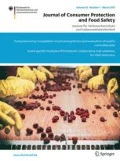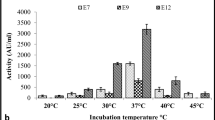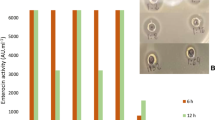Abstract
The objectives of this study were to characterize the antibacterial substances produced by Enterococcus faecium YT52 isolated from boza, and to evaluate the safety of this strain. E. faecium YT52 inhibits various Gram-positive bacteria, including foodborne pathogens such as Listeria monocytogenes and Bacillus cereus. The manner of action of its antibacterial activity, using proteolytic enzymes, indicate that it produces a bacteriocin. The bacteriocin producing isolate E. faecium YT52 was identified using 16S rRNA gene homology and species-specific polymerase chain reaction (PCR) analysis. The bacteriocin was found to be heat stable and active under both acid and alkaline conditions. The bacteriocin showed primary metabolite kinetics and a bactericidal mode of action against L. monocytogenes. Although enterocin A, B and X genes were detected in E. faecium YT52 by PCR, only one active peptide band (~ 5.5 kDa) with a molecular weight similar to enterocin B was identified by tricine–SDS-PAGE analysis. A safety evaluation of E. faecium YT52 indicated that it is nonhemolytic, gelatinase-negative, and susceptible to clinically relevant antibiotics such as ampicillin, tetracycline and vancomycin. It contains a small number of virulence factors (efaAfm, silent gelE) and antibiotic resistance genes (ermB, tetM, tetL). In conclusion, bacteriocinogenic E. faecium YT52 was found to have a low risk profile, and it may be potentially valuable as a protective culture in the food industry.





Similar content being viewed by others
References
Aarestrup FM, Agerso Y, Gerner-Smidt P, Madsen M, Jensen LB (2000) Comparison of antimicrobial resistance phenotypes and resistance genes in Enterococcus faecalis and Enterococcus faecium from humans in the community, broilers, and pigs in Denmark. Diagn Microbiol Infect Dis 37:127–137
Arıcı M, Daglıoglu O (2002) Boza: a lactic acid fermented cereal beverage as a traditional Turkish food. Food Res Int 18:39–48
Avci M, Özden Tuncer B (2017) Safety evaluation of enterocin producer Enterococcus sp. strains isolated from traditional Turkish cheeses. Polish J Microbiol 66:223–233
Aymerich T, Holo H, Havastein LS, Hugas M, Garriga M, Nes IF (1996) Biochemical and genetic characterization of enterocin A from Enterococcus faecium, a new antilisterial bacteriocin in the pediocin family of bacteriocins. Appl Environ Microbiol 62:1676–1682
Ben Barïek O, Cremonesi P, Morandi S, Smaoui S, Hani K, Ghrairi T (2018) Safety characterization and inhibition of fungi and bacteria by a novel multiple enterocin-producing Enterococcus lactis 4CP3 strain. Microb Pathog 118:32–38
Ben Belgacem Z, Abriouel H, Ben Omar N, Lucas R, Martínez-Canamero M, Gálvez A, Manai M (2010) Antimicrobial activity, safety aspects, and some technological properties of bacteriocinogenic Enterococcus faecium from artisanal Tunisian fermented meat. Food Control 21:462–470
Cancilla MR, Powell IB, Hillier AJ, Davidson BE (1992) Rapid genomic fingerprinting of Lactococcus lactis strains by arbitrarily primed polymerase chain reaction with 32P and fluorescent labels. Appl Environ Microbiol 58:1772–1775
Cariolato D, Andrighetto C, Lombardi A (2008) Occurrence of virulence factors and antibiotic resistances in Enterococcus faecalis and Enterococcus faecium collected from dairy and human samples in North Italy. Food Control 19:886–892
Casaus P, Nilsen T, Cintas LM, Nes IF, Hernandez PE, Holo H (1997) Enterocin B, a new bacteriocin from Enterococcus faecium T136 which can act synergistically with enterocin A. Microbiology 143:2287–2294
Cauwerts K, Decostere A, De Graef EM, Haesebrouck F, Pasmans F (2007) High prevalence of tetracycline resistance in Enterococcus isolates from broilers carrying the erm(B) gene. Avian Pathol 36:395–399
Chajęcka-Wierzchowska W, Zandernowska A, Łaniewska-Trokenheim Ł (2017) Virulence factors of Enterococcus spp. presented in food. LWT-Food Sci Technol 75:670–676
CLSI Clinical and Laboratory Standards Institute (2012) Performance standards for antimicrobial disk susceptibility tests; approved standard, vol 32(1), 11th edn. CLSI, St. Louis (M02-A11)
De Vuyst L, Vandamme EJ (1994) Bacteriocins of lactic acid bacteria. Microbiology, genetics and applications. Chapman and Hall, New York, p 539
De Vuyst L, Foulquié Moreno MR, Revets H (2003) Screening for enterocins and detection of hemolysin and vancomycin resistance in enterococci of different origins. Int J Food Microbiol 84:299–318
Demirgül F, Tuncer Y (2017) Detection of antibiotic resistance and resistance genes in enterococci isolated from sucuk, a traditional Turkish dry-fermented sausage. Korean J Food Sci Anim Resour 37(5):670–681
Dutka-Malen S, Evers S, Courvalin P (1995) Detection of glycopeptide resistance genotypes and identification to the species level of clinically relevant enterococci by PCR. J Clinic Microbiol 33:24–27
Eaton T, Gasson MJ (2001) Molecular screening of Enterococcus virulence determinants and potential for genetic exchange between food and medical isolates. Appl Environ Microbiol 67:1628–1635
Edalatian MR, Najafi MBH, Mortazavi SA, Alegría Á, Delgado S, Bassami MR, Mayo B (2012) Production of bacteriocins by Enterococcus spp. isolated from traditional, Iranian, raw milk cheeses, and detection of their encoding genes. Eur Food Res Technol 234:789–796
Edwards U, Rogall T, Blocker H, Emde M, Bottger EC (1989) Isolation and direct complete nucleotide determination of entire genes. Characterization of a gene coding for 16S ribosomal RNA. Nucleic Acids Res 17:7843–7853
Favaro L, Basaglia M, Casella S, Hue I, Dousset X, de Melo Franco BDG, Todorov SD (2014) Bacteriocinogenic potential and safety evaluation of non-starter Enterococcus faecium strains isolated from home made white brine cheese. Food Microbiol 38:228–239
Foulquié Moreno MR, Callewaert R, Devreese B, Van Beeumen J, De Vuyst L (2003) Isolation and biochemical characterisation of enterocins produced by enterococci from different sources. J Appl Microbiol 94:214–229
Franz CMAP, Du Toit M, von Holy A, Schillinger U, Holzapfel WH (1997) Production of nisin-like bacteriocins by Lactococcus lactis strains isolated from vegetables. J Basic Microbiol 37:187–196
Garrido AM, Gálvez A, Pulido RP (2014) Antimicrobial resistance in Enterococci. J Infect Dis Ther 2:150
Gharairi T, Frere J, Berjeaud J, Manai M (2008) Purification and chacterisation of bacteriocins produced by Enterococcus faecium from Tunisian rigouta cheese. Food Control 19:162–169
Hadji-Sfaxi I, El-Ghaish S, Ahmadova A, Batdorj B, Le Blay-Laliberté G, Barbier G, Haertlé T, Chobert J-M (2011) Antimicrobial activity and safety of use of Enterococcus faecium PC4.1 isolated from Mongol yogurt. Food Control 22:2020–2027
Hernández D, Cardell E, Zárate V (2005) Antimicrobial activity of lactic acid bacteria isolated from Tenerife cheese: initial characterization of plantaricin TF711, a bacteriocin-like substance produced by Lactobacillus plantarum TF711. J Appl Microbiol 99:77–84
Hu C-B, Malaphan W, Zendo T, Nakayama J, Sonomoto K (2010) Enterocin X, a novel two-peptide bacteriocin from Enterococcus faecium KU-B5, has an antibacterial spectrum entirely different from those of its component peptides. Appl Environ Microbiol 76:4542–4545
Inoğlu ZN, Tuncer Y (2013) Safety assessment of Enterococcus faecium and Enterococcus facalis strains isolated from Turkish tulum cheese. J Food Safety 33:369–377
Iranmanesh M, Ezzatpanah H, Mojgani N, Mak T (2015) Characterization and kinetics of growth of bacteriocin like substance produced by lactic acid bacteria isolated from ewe milk and traditional sour buttermilk in Iran. J Food Process Technol 6:529
Isleroglu H, Yıldırım Z, Tokatlı M, Oncul N, Yıldırım M (2012) Partial characterization of enterocin KP produced by Enterococcus faecalis KP, a cheese isolate. Int J Dairy Technol 65:90–96
Ivanova I, Kabadjova P, Pantev A, Danova S, Dousset X (2000) Detection, purification and partial characterization of a novel bacteriocin substance produced by Lactococcus lactis subsp. lactis B14 isolated from boza—Bulgarian traditional cereal beverage. Biocatalysis 41:47–53
Jackson CR, Fedorka-Cray PJ, Barrett JB (2004) Use of a genus- and species-specific multiplex PCR for identification of enterococci. J Clin Microbiol 42(8):3558–3565
Jahan M, Krause DO, Holley RA (2013) Antimicrobial resistance of Enterococcus species from meat and fermented meat products isolated by a PCR-based rapid screening method. Int Food Microbiol 163:89–95
Kabak B, Dobson ADW (2011) An introduction to the traditional fermented foods and beverages of Turkey. Crit Rev Food Sci Nutr 51:248–260
Ke D, Picard FJ, Martineau F, Ménard C, Roy PH, Ouellette M, Bergeron MG (1999) Development of a PCR assay for rapid detection of enterococci. J Clin Microbiol 37:3497–3503
Klaenhammer T (1988) Bacteriocins of lactic acid bacteria. Biochimie 70:337–349
Koral G, Tuncer Y (2014) Nisin Z-producing Lactococcus lactis subsp. lactis GYL32 isolated from Boza. J Food Process Preserv 38:1044–1053
Lee H-J, Kim WJ (2010) Isolation and characterization of anti-listerial and amylase sensitive enterocin producing Enterococcus faecium DB1 from Gajami-sikhae, a fermented flat fish in Korea. Food Sci Biotechnol 19:373–381
Marco ML, Heeney D, Binda S, Cifelli CJ, Cotter PD, Foligné B, Gänzle M, Kort R, Pasin G, Pihlato A, Smid EJ, Hutkins R (2017) Health benefits of fermented foods: microbiota and beyond. Curr Opin Biotechnol 44:94–102
Mojsova S, Krstevski K, Dzadzovski I, Popova Z, Sekulovski P (2015) Phenotypi and genotypic characteristics of enterocin producing enterococci against pathogenic bacteria. Mac Vet Rev 38(2):209–216
Morandi S, Brasca M, Andrighetto C, Lombardi A, Lodi R (2006) Technological and molecular characterisation of enterococci isolated from North-West Italian dairy products. Int Dairy J 16:867–875
Ndlovu B, Schoeman H, Franz CMAP, du Toit M (2015) Screening, identification and characterization of bacteriocins produced by wine-isolated LAB strains. J Appl Microbiol 118:1007–1022
Ogier JC, Serror P (2008) Safety assessment of dairy microorganisms: the Enterococcus genus. Int J Food Microbiol 126:291–301
Ouoba LII, Lei V, Jensen LB (2008) Resistance of potential probiotic lactic acid bacteria and bifidobacteria of African and European origin to antimicrobials: determination and transferability of the resistance genes to other bacteria. Int J Food Microbiol 121:217–224
Özden Tuncer B, Ay Z, Tuncer Y (2013) Occurrence of enterocin genes, virulence factors and antibiotic resistance in three bacteriocin producer Enterococcus faecium strains isolated from Turkish tulum cheese. Turkish J Biol 37:443–449
Özmen Toğay S, Ay M, Güneşer O, Karagül Yüceer Y (2016) Investigation of antimicrobial activity and entA and entB genes in Enterococcus faecium and Enterococcus faecalis strains isolated from naturally fermented Turkish white cheeses. Food Sci Biotechnol 25:1633–1637
Poeta P, Igrejas G, Costa D, Sargo R, Rodrigues J, Torres C (2008) Virulence factors and bacteriocin in faecal enterococci of wild boars. J Basic Microbiol 48:385–392
Reviriego C, Eaton T, Martín R, Jiménez E, Fernández L, Gasson MJ, Rodríguez JM (2005) Screening of virulence determinants in Enterococcus faecium strains isolated from breast milk. J Hum Lac 21:131–137
Rice LB (1998) Tn916 family conjugative transposons and dissemination of antimicrobial resistance determinants. Antimicrob Agents Chemother 42:1871–1877
Ryan MP, Rea MC, Hill C, Ross RP (1996) An application in cheddar cheese manufacture for a strain of Lactococcus lactis producing a novel broad spectrum bacteriocin lacticin 3147. Appl Environ Microbiol 62:612–619
Şahingil D, İşleroğlu H, Yildirim Z, Akçelik M, Yildirim M (2011) Characterization of lactococcin BZ produced by Lactococcus lactis subsp. lactis BZ isolated from boza. Turkish J Biol 35:21–33
Schägger H, von Jagow G (1987) Tricine–SDS-PAGE for the separation of proteins in the range from 1 to 100 kDa. Anal Biochem 166:368–379
Semedo T, Almeida M, Silva Lopes MF, Figueiredo Marques JJ, Barreto Crespo MT, Tenreiro R (2003) Virulence factors in food, clinical and reference enterococci: a common trait in the genus? Sys Appl Microbiol 26:13–22
Tamang JP, Watanabe K, Holzapfel WH (2016) Review: diversity of microorganisms in global fermented foods and beverages. Front Microbiol 7:1–28
Todorov SD (2010) Diversity of bacteriocinogenic lactic acid bacteria isolated from boza, a cereal-based fermented beverage from Bulgaria. Food Control 21:1011–1021
Todorov SD, Dicks LMT (2004) Characterization of mesentericin ST99, a bacteriocin produced by Leuconostoc mesenteroides subsp. dextranicum ST99 isolated from Boza. J Indian Microbiol Biotechnol 31:323–329
Todorov SD, Dicks LMT (2005a) Production of bacteriocin ST33LD by Leuconostoc mesenteroides subsp. mesenteroides, as recorded in the presence of different medium components. World J Microbiol Biotechnol 21:1585–1590
Todorov SD, Dicks LMT (2005b) Pediocin ST18, an anti-listerial bacteriocin produced by Pediococcus pentosaceus ST18 isolated from Boza, a traditional cereal beverage from Bulgaria. Process Biochem 40:365–370
Todorov SD, Dicks LMT (2006) Screening for bacteriocin-producing lactic acid bacteria from Boza, a traditional cereal beverage from Bulgaria: comparison of the bacteriocins. Process Biochem 41:11–19
Tuncer Y (2009) Some technological properties of phenotypically identified enterococci strains isolated from Turkish tulum cheese. Afr J Biotechnol 8:7008–7016
Tuncer Y, Özden B (2010) Partial biochemical characterization of nisin-like bacteriocin produced by Lactococcus lactis subsp. lactis YBD11 isolated from boza, a traditional fermented Turkish beverage. Rom Biotechnol Lett 15:4940–4948
Tuncer M, Özden Tuncer B, Tuncer Y (2014) Safety evaluation of enterocin B producer Enterococcus faecalis MYE58 strain isolated from raw milk. Gıda 39(5):275–282 (in Turkish)
van Belkum MJ, Hayema BJ, Geis A, Kok J, Venema G (1989) Cloning of two bacteriocin genes from a lactococcal bacteriocin plasmid. Appl Environ Microbiol 55:1187–1191
Von Mollendorff JW, Todorov SD, Dicks LMT (2006) Comparison of bacteriocins produced by lactic acid bacteria isolated from boza, a cereal-based fermented beverage from the Balkan Peninsula. Curr Microbiol 53:209–216
Yogurtcu NN, Tuncer Y (2013) Antibiotic susceptibility patterns of Enterococcus strains isolated from Turkish Tulum cheese. Int J Dairy Technol 66(2):236–242
Yousif NMK, Dawyndt P, Abriouel H, Wijaya A, Schillinger U, Vancanneyt M, Swings J, Dirar HA, Holzapfel WH, Franz CMAP (2005) Molecular characterization, technological properties and safety aspects of enterococci from “Hussuwa”, an African fermented sorghum product. J Appl Microbiol 96:216–228
Zorba M, Hancioglu O, Genc M, Karapinar M, Ova G (2003) The use of starter cultures in the fermentation of boza, a traditional Turkish beverage. Process Biochem 38:1405–1411
Acknowledgements
This study was supported by the Scientific Research Fund of the Süleyman Demirel University through project no. 3914-YL2-14. Two posters prepared as part of this study were presented at the Food Factor I Conference in Barcelona, Spain, and they were published as abstracts in the Proceedings.
Author information
Authors and Affiliations
Corresponding author
Ethics declarations
Conflict of interest
The authors declare that they have no conflict of interest.
Additional information
Publisher's Note
Springer Nature remains neutral with regard to jurisdictional claims in published maps and institutional affiliations.
Rights and permissions
About this article
Cite this article
Gök Charyyev, M., Özden Tuncer, B., Akpınar Kankaya, D. et al. Bacteriocinogenic properties and safety evaluation of Enterococcus faecium YT52 isolated from boza, a traditional cereal based fermented beverage. J Consum Prot Food Saf 14, 41–53 (2019). https://doi.org/10.1007/s00003-019-01213-9
Received:
Revised:
Accepted:
Published:
Issue Date:
DOI: https://doi.org/10.1007/s00003-019-01213-9




